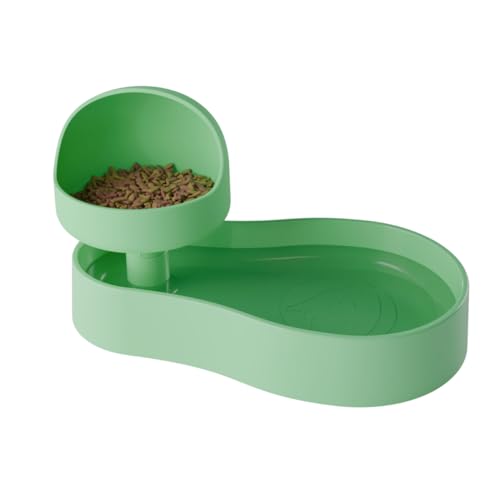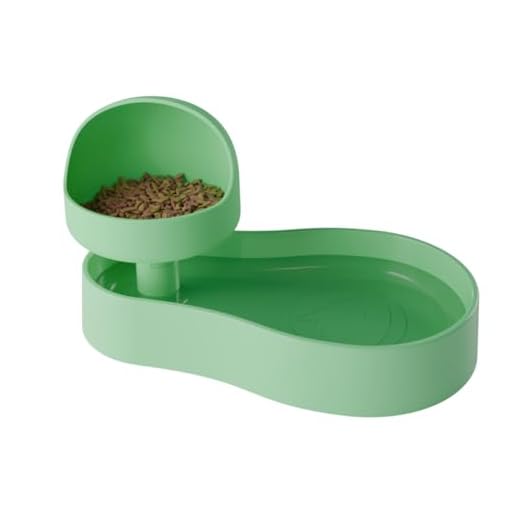



Using a raised feeding station is a simple yet effective approach. Elevating the bowl not only keeps it away from ground-dwelling critters but also makes it less accessible to those tiny invaders. Consider using a table or a platform specifically designed for this purpose.
Implementing barriers can significantly help in this battle. Placing the bowl within a shallow dish filled with water creates a moat that deters many insects from making their way to the meal. Ensure the water level is sufficient to prevent any uninvited guests from crossing.
Another strategy involves strategically timing the meals. Feeding at specific intervals and removing any leftovers promptly minimizes the chances of attracting unwanted visitors. This way, there is less time for these nuisances to discover the delightful offerings.
Employing natural repellents can also be beneficial. Sprinkling cinnamon or using citrus peels around the feeding area can be a deterrent. Many insects dislike these scents and will likely steer clear of the vicinity.
Lastly, maintaining cleanliness around the feeding zone is paramount. Regularly cleaning the area helps eliminate any lingering scents that may attract pests. A tidy environment not only benefits me but also keeps the surroundings pleasant for everyone.
Preventing Pests from Invading My Meal
Using a raised feeder can significantly deter unwelcome visitors. Elevating my dish makes it harder for these little invaders to access my meals. Look for a sturdy platform that holds my bowl securely. Choosing one with a smooth surface is ideal, as it minimizes clingy creatures finding footholds.
Creating a Barrier
Applying a natural deterrent around my dining area works wonders. Substances like diatomaceous earth or cinnamon sprinkled along the perimeter act as an effective barrier. These materials are harmless to me but discourage intruders from crossing the line.
Monitoring for Leftovers
Regularly checking for leftover morsels is crucial. I ensure my bowl is emptied after meals, reducing the chances of attracting unwanted guests. Keeping the feeding area clean helps maintain a pest-free zone.
| Tip | Description |
|---|---|
| Raised Feeder | Elevate the bowl to make it challenging for pests to reach. |
| Natural Deterrents | Use diatomaceous earth or cinnamon around the feeding area. |
| Regular Cleaning | Check and empty the bowl after meals to avoid attracting pests. |
Choosing the Right Feeding Location for Your Feline Friend
Placing my meals in a sheltered area, away from direct sun and rain, ensures they stay fresh and appealing. A shaded spot under a tree or patio can be ideal. The surface should be flat and stable to prevent spills and make it easy for me to enjoy my meals without distractions.
Elevating the feeding station can deter unwanted visitors. Using a raised platform or a sturdy table keeps my dining area out of reach for critters looking for a snack. This also provides a safe vantage point, allowing me to watch my surroundings while I eat.
Choosing a location with minimal foot traffic is crucial. I prefer a quiet corner of the yard or garden, where I can feel secure while munching on my kibble. This reduces the chance of disturbances and allows me to enjoy my meals peacefully.
Regularly cleaning the area around my feeding spot is a must. Keeping the surroundings free of debris and leftover scraps helps maintain hygiene and minimizes attraction for unwanted pests. After meals, I appreciate when my humans tidy up to keep everything neat.
For health reasons, placing my dish away from any chemicals, such as fertilizers or pesticides, is vital. A safe and clean environment ensures I stay healthy and happy. Also, it’s wise to monitor my feeding area for signs of unwelcome guests, like droppings or trails.
Lastly, consider the weather. During rainy or windy days, I prefer my meals served in a more sheltered spot. Ensuring my dining experience remains comfortable is the best way to keep me satisfied and healthy, especially if my humans use a quality otc dewormer for cats to maintain my well-being.
Using Ant-Proof Containers for Cat Food
Choose containers designed specifically to prevent unwanted visitors. Look for models with tight-fitting lids that seal securely. Materials like stainless steel or heavy-duty plastic are great options, as they resist chewing and are easy to clean.
Consider containers with elevated bases. This feature can deter small insects from accessing the food. Some designs even come with built-in barriers, utilizing a moat-like structure that can be filled with water to create an extra layer of protection.
Invest in a container with a locking mechanism. This adds an extra layer of security, ensuring that the contents remain untouched. Many modern models are also airtight, which helps in maintaining the freshness of the kibble.
Regularly clean the containers to remove any residual crumbs or odors that might attract uninvited guests. Use warm, soapy water, and rinse thoroughly before refilling.
When selecting a container, ensure it has a capacity that matches your feeding routine. Purchasing in bulk can save money, but make sure the container can hold enough without compromising on safety.
In summary, a well-chosen, secure container not only protects the meal but also contributes to a healthier feeding environment. Trust me; it’s worth the investment!
Implementing Natural Deterrents Around Feeding Areas
Using cinnamon is one of my favorite tips. Sprinkling this spice around my dish creates a barrier that bugs dislike. I enjoy the aroma, and it effectively keeps unwanted visitors at bay.
Another great option is diatomaceous earth. This natural powder can be spread around the feeding spot. It’s harmless to me and my human but acts as a barrier for crawling nuisances. Just remember to reapply it after rain.
Essential oils also serve as a strong ally. A mixture of peppermint or tea tree oil diluted with water can be sprayed around my feeding zone. The scent is pleasant, and it helps to repel uninvited guests without harming anyone.
Using citrus peels can help too. Placing orange or lemon peels near my bowl deters many creatures due to the strong scent. Plus, it adds a fresh touch to the area.
Creating a barrier with plants is another option. Planting herbs like mint or rosemary nearby can naturally repel those tiny intruders while adding greenery to the space.
For those who enjoy DIY projects, mixing soap with water and spraying it around the area can disrupt the pests’ movement. It’s an easy solution that doesn’t involve harsh chemicals.
Lastly, keeping the space clean and free from spills is vital. Regularly cleaning the feeding area ensures that there are no lingering scents attracting visitors. This way, I can enjoy my meals without interruptions.
For a quiet work environment while preparing these solutions, consider checking out the best quietest air compressor. It helps maintain a peaceful atmosphere during the process.
Regular Cleaning and Maintenance of Feeding Stations
After every meal, I ensure the feeding area is spotless. Scraping off any leftover remnants is crucial. A clean surface discourages unwanted visitors, including those little intruders. I use a damp cloth to wipe the feeding station, removing any crumbs or spills that might attract them.
Every week, I inspect the feeding station thoroughly. If I notice any signs of pests or grime buildup, I take action immediately. I recommend using a mild soap solution for a deeper clean, followed by rinsing with water. This keeps the area fresh and unappealing to unwanted guests.
It’s also a good idea to rotate the feeding spot occasionally. Shifting locations not only helps deter those tiny nuisances but also allows me to monitor different areas for any signs of invasion. I pay attention to the surrounding environment, keeping it free of debris and vegetation that might harbor them.
Using a designated feeding mat can also help. It catches spills and makes cleaning easier. After meals, I simply lift the mat and shake it out or wash it as needed. This small addition makes a big difference in maintaining hygiene.
Lastly, I keep an eye on the weather. Rain or moisture can create ideal conditions for unwanted visitors. If I anticipate wet weather, I make sure to clean the station right before it hits. Staying proactive is key to a clean and safe dining area.
Monitoring and Adjusting Feeding Practices to Reduce Attractiveness
Set specific feeding times for meals. This strategy minimizes exposure, making it harder for tiny intruders to find a steady food supply. I enjoy my meals at the same times each day, and it keeps everything fresh and appealing for me.
Portion control is key. Instead of filling the bowl to the brim, serve just enough for a single meal. This approach ensures that leftovers don’t linger, reducing the likelihood of attracting unwanted visitors.
Observe the environment closely. If you notice an uptick in unwanted visitors during certain times, adjust the feeding schedule accordingly. For instance, if they seem more active in the morning, consider moving my meals to the late afternoon.
Monitor feeding locations regularly. If one spot becomes a hotspot for those little nuisances, it might be time for a change. Experiment with different areas in the yard to find a less trafficked spot.
Evaluate the type of nourishment provided. Some options are more enticing to critters than others. Consider trying different brands or formulations to see if it helps reduce the appeal.
Lastly, keep track of any changes in behavior. If I seem hesitant to eat or if there are more visitors than usual, it’s time to reassess the entire feeding setup. Making small tweaks can lead to a more enjoyable dining experience for me without the unwelcome guests.










